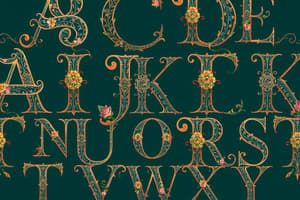Podcast
Questions and Answers
What is the main purpose of using uppercase letters in writing?
What is the main purpose of using uppercase letters in writing?
- To separate words in a sentence
- To indicate the end of a paragraph
- To add emphasis to a sentence
- To start sentences and denote proper nouns (correct)
Which of the following skills is not directly related to understanding alphabet sequencing?
Which of the following skills is not directly related to understanding alphabet sequencing?
- Developing math skills (correct)
- Developing reading skills
- Arranging words in alphabetical order
- Finding words in dictionaries
What type of letter sound is the combination of 'sh' in the word 'shop'?
What type of letter sound is the combination of 'sh' in the word 'shop'?
- Vowel combination
- Digraph (correct)
- Vowel sound
- Consonant sound
What is the role of uppercase letters in writing names of people?
What is the role of uppercase letters in writing names of people?
Which of the following is a benefit of understanding letter sounds?
Which of the following is a benefit of understanding letter sounds?
What is the total number of letters in the modern English alphabet?
What is the total number of letters in the modern English alphabet?
What is the primary importance of letter recognition in literacy development?
What is the primary importance of letter recognition in literacy development?
What is the main difference between uppercase and lowercase letters?
What is the main difference between uppercase and lowercase letters?
What strategy is most effective for teaching letter recognition?
What strategy is most effective for teaching letter recognition?
Why is the multisensory approach effective in teaching letter recognition?
Why is the multisensory approach effective in teaching letter recognition?
What is the benefit of using alphabet songs and rhymes in teaching letter recognition?
What is the benefit of using alphabet songs and rhymes in teaching letter recognition?
What type of activities can be used to engage students in letter recognition?
What type of activities can be used to engage students in letter recognition?
Flashcards are hidden until you start studying
Study Notes
Uppercase Letters
- There are 26 uppercase letters in the modern English alphabet.
- Uppercase letters are also known as capital letters.
- They are used to:
- Start sentences
- Begin proper nouns (names of people, places, etc.)
- Emphasize importance or distinction
- Examples of uppercase letters: A, B, C, ..., X, Y, Z
Alphabet Sequencing
- The alphabet is a sequence of 26 letters in a specific order.
- The sequence is: A, B, C, D, E, F, G, H, I, J, K, L, M, N, O, P, Q, R, S, T, U, V, W, X, Y, Z
- Understanding alphabet sequencing is essential for:
- Arranging words in alphabetical order
- Finding words in dictionaries and phonebooks
- Developing reading and writing skills
Letter Sounds
- Each letter of the alphabet has a distinct sound or sounds.
- There are two types of letter sounds:
- Vowel sounds: A, E, I, O, U (sometimes Y)
- Consonant sounds: all letters except vowels
- Letter sounds can be:
- Single sounds (e.g., "m" makes the /m/ sound)
- Digraphs (two letters making one sound, e.g., "sh" makes the /ʃ/ sound)
- Vowel combinations (e.g., "ea" makes the /iː/ sound in "seat")
- Understanding letter sounds is crucial for:
- Decoding words when reading
- Encoding words when writing
- Developing phonemic awareness and phonics skills
Uppercase Letters
- There are 26 uppercase letters in the modern English alphabet, also known as capital letters.
- Uppercase letters are used to start sentences, begin proper nouns (names of people, places, etc.), and emphasize importance or distinction.
- Examples of uppercase letters include A, B, C, ..., X, Y, Z.
Alphabet Sequencing
- The alphabet is a sequence of 26 letters in a specific order: A, B, C, D, E, F, G, H, I, J, K, L, M, N, O, P, Q, R, S, T, U, V, W, X, Y, Z.
- Understanding alphabet sequencing is essential for arranging words in alphabetical order, finding words in dictionaries and phonebooks, and developing reading and writing skills.
Letter Sounds
- Each letter of the alphabet has a distinct sound or sounds.
- There are two types of letter sounds: vowel sounds (A, E, I, O, U, and sometimes Y) and consonant sounds (all letters except vowels).
- Letter sounds can be single sounds (e.g., "m" makes the /m/ sound), digraphs (two letters making one sound, e.g., "sh" makes the /ʃ/ sound), or vowel combinations (e.g., "ea" makes the /iː/ sound in "seat").
- Understanding letter sounds is crucial for decoding words when reading, encoding words when writing, and developing phonemic awareness and phonics skills.
Letter Recognition
Definition
- Ability to identify and name uppercase and lowercase letters of the alphabet
Importance
- Essential for reading and writing skills
- Builds foundation for phonemic awareness and decoding
- Crucial for literacy development and acquisition
Key Concepts
Uppercase and Lowercase Letters
- 26 uppercase letters, also known as "big letters" (e.g., A, B, C)
- 26 lowercase letters, also known as "little letters" (e.g., a, b, c)
Letter Forms and Sounds
- Uppercase and lowercase letters have distinct shapes and features
- Letters represent phonemes (sounds) in words
Strategies for Teaching Letter Recognition
Instructional Approaches
- Use visual aids like flashcards, posters, and alphabet charts to display letters
- Incorporate multisensory activities, combining visual, auditory, and kinesthetic approaches
- Focus on accurate letter naming, going beyond just recognition
Engaging Instructional Tools
- Utilize the alphabet song and rhymes to aid letter recognition and sequence memory
- Engage students in letter-based games, such as matching, sorting, and scavenger hunts
Studying That Suits You
Use AI to generate personalized quizzes and flashcards to suit your learning preferences.




